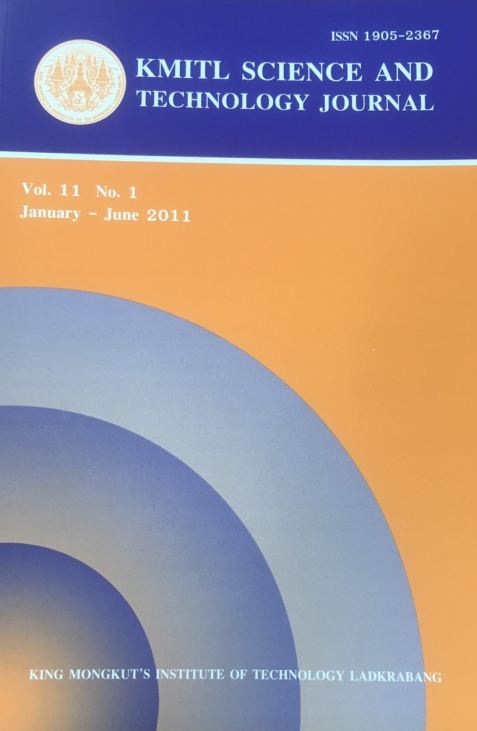Microbial Diversity in Thermophilic Adaptation on Pome Treatment
Main Article Content
Abstract
Microbial diversity in a thermopilic UASB reactor producing biogas from palm oil mill effluent (POME) was investigated. The PCR-based DGGE analysis showed that the microbial population profiles changed with the temperature transition from mesophilic to thermophilic conditions. Acetotrophic and hydrogenotrophic methanogens were found in all three phases: the seed sludge, transition from mesophilic to thermophilic condition and operation under the thermophilic condition. The hydrolytic and acidogenic bacteria were found in the seed sludge, while only hydrolytic bacteria were found during the transition and hydrolytic, acidogenic and acetogenic bacteria were presented under the thermophilic condition. The microbial profiles were highly diversified under the thermophilic condition. The results suggested that the temperature transition strategy was suitable for proliferation of the microorganisms both in the seed sludge and in POME.
Keywords: Anaerobic, methanogens, POME, UASB, thermophilic
*Corresponding author: Tel: +66(0)891353253 Fax: +66(0)25870024
E-mail: cpk@kmutnb.ac.th, cphalak21@yahoo.com
Article Details
Copyright Transfer Statement
The copyright of this article is transferred to Current Applied Science and Technology journal with effect if and when the article is accepted for publication. The copyright transfer covers the exclusive right to reproduce and distribute the article, including reprints, translations, photographic reproductions, electronic form (offline, online) or any other reproductions of similar nature.
The author warrants that this contribution is original and that he/she has full power to make this grant. The author signs for and accepts responsibility for releasing this material on behalf of any and all co-authors.
Here is the link for download: Copyright transfer form.pdf
References
[2] Choorit, W. and Wisarnwan, P. 2007. Effect of temperature on the anaerobic digestion of palm oil mill effluent. Electronic Journal of Biotechnology, 10(3), 376-385.
[3] Prasertsan, S. and Prasertsan, P. 1996. Biomass residues from palm oil mills in Thailand: An overview on quantity and potential usage, Biomass and Bioenergy, 11(5), 387-395.
[4] Poh, P. E. and Chong, M. F. 2009. Development of anaerobic digestion methods for palm oil mill effluent (POME) treatment. Bioresource Technology, 100(1), 1-9.
[5] Yu, H. -Q., Fang, H. H. P. and. Gu, G. -W 2002. Comparative performance of mesophilic and thermophilic acidogenic upflow reactors. Process Biochemistry, 38(3), 447-454.
[6] Quarmby, J. and Forster, C. F. 1995. A comparative study of the structure of thermophilic and mesophilic anaerobic granules. Enzyme and Microbial Technology, 17(6), 493-498.
[7] Ahn, J. H. and Forster, C. F. 2000. A comparison of mesophilic and thermophilic anaerobic upflow filters. Bioresource Technology, 73(3), 201-205.
[8] Lee, C., et al. 2009. Quantitative analysis of methanogenic community dynamics in three anaerobic batch digesters treating different wastewaters. Water Research, 43, 157-165.
[9] Yang, Y., Tsukahara, K. and Sawayama, S. 2008. Biodegradation and methane production from glycerol-containing synthetic wastes with fixed-bed bioreactor under mesophilic and thermophilic anaerobic conditions. Process Biochemistry, 43(4), 362-367.
[10] APHA, AWWA, WEF. 2005. Standard methods for the examination of water and wastewater. Eaton A. D., L. S. Clesceri, and A. E. Greenberg, Editors. Washington, D.C.
[11] Zhou, J.,. Bruns, M. A and Tiedje, J. M. 1996. DNA recovery from soils of diverse composition. Applied and Environmental Microbiology, 62(2), 316-322.
[12] Amann, R., Ludwig, W. and Schleifer, K. H. 1995. Phylogenetic identification and in situ detection of individual microbial cells without cultivation. Microbiology Reviews, 59, 143-169.
[13] Moyer, C. L., Dobbs, F. C. and Karl, D. M. 1994. Estimation of diversity and community structure through restriction fragment length polymorphism distribution analysis of bacterial 16S rRNA genes from a microbial mat at an active, hydrothermal vent system, Loihi Seamount, Hawaii. Applied and Environmental Microbiology, 60(3), 871-879.
[14] Orphan, V. J., et al. 2000. Culture-dependent and culture-independent characterization of microbial assemblages associated with high-temperature petroleum resevoirs. Applied and Environmental Microbiology, 66, 700-711.
[15] Amann, R.I., et al. 1990. Combination of 16S rRNA-targeted oligonucleotide probes with flow cytometry for analyzing mixed microbial populations. Applied and Environmental Microbiology, 56(6), 1919-1925.
[16] Muyzer, G., De Waal, E. C. and Uitterlinden, A. G. 1993. Profiling of complex microbial populations by denaturing gradient gel electrophoresis analysis of polymerase chain reaction-amplified genes coding for 16S rRNA. Applied and Environmental Microbiology, 59(3), 695-700.
[17] Raskin, L., et al. 1994. Quantification of methanogenic groups in anaerobic biological reactors by oligonucleotide probe hybridization. Applied and Environmental Microbiology, 60, 1241-1248.
[18] Øvreås, L., et al. 1997. Distribution of bacterioplankton in meromictic lake Sælenvannet, as determined by denaturing gradient gel electrophoresis of PCR-amplified gene fragments coding for 16S rRNA. Applied and Environmental Microbiology, 63(9), 3367-3373.
[19] Shigematsu, T., et al. 2006. Microbial diversity of mesophilic methanogenic consortium that can degrade long-chain fatty acids in chemostat cultivation. Journal of Bioscience and Bioengineering, 102(6), 535-544.
[20] Keyser M, et al. 2006. PCR-based DGGE fingerprinting and identification of methanogens detected in three different types of UASB granules. Systematic and Applied Microbiology, 29, 77-84.
[21] Keyser, M., et al. 2006. PCR-based DGGE fingerprinting and identification of methanogens detected in three different types of UASB granules. Systematic and Applied Microbiology, 29, 77-84.


